Jiahui Zhao
RankFlow: A Multi-Role Collaborative Reranking Workflow Utilizing Large Language Models
Feb 04, 2025Abstract:In an Information Retrieval (IR) system, reranking plays a critical role by sorting candidate passages according to their relevance to a specific query. This process demands a nuanced understanding of the variations among passages linked to the query. In this work, we introduce RankFlow, a multi-role reranking workflow that leverages the capabilities of Large Language Models (LLMs) and role specializations to improve reranking performance. RankFlow enlists LLMs to fulfill four distinct roles: the query Rewriter, the pseudo Answerer, the passage Summarizer, and the Reranker. This orchestrated approach enables RankFlow to: (1) accurately interpret queries, (2) draw upon LLMs' extensive pre-existing knowledge, (3) distill passages into concise versions, and (4) assess passages in a comprehensive manner, resulting in notably better reranking results. Our experimental results reveal that RankFlow outperforms existing leading approaches on widely recognized IR benchmarks, such as TREC-DL, BEIR, and NovelEval. Additionally, we investigate the individual contributions of each role in RankFlow. Code is available at https://github.com/jincan333/RankFlow.
Adapting Whisper for Code-Switching through Encoding Refining and Language-Aware Decoding
Dec 24, 2024


Abstract:Code-switching (CS) automatic speech recognition (ASR) faces challenges due to the language confusion resulting from accents, auditory similarity, and seamless language switches. Adaptation on the pre-trained multi-lingual model has shown promising performance for CS-ASR. In this paper, we adapt Whisper, which is a large-scale multilingual pre-trained speech recognition model, to CS from both encoder and decoder parts. First, we propose an encoder refiner to enhance the encoder's capacity of intra-sentence swithching. Second, we propose using two sets of language-aware adapters with different language prompt embeddings to achieve language-specific decoding information in each decoder layer. Then, a fusion module is added to fuse the language-aware decoding. The experimental results using the SEAME dataset show that, compared with the baseline model, the proposed approach achieves a relative MER reduction of 4.1% and 7.2% on the dev_man and dev_sge test sets, respectively, surpassing state-of-the-art methods. Through experiments, we found that the proposed method significantly improves the performance on non-native language in CS speech, indicating that our approach enables Whisper to better distinguish between the two languages.
CMoralEval: A Moral Evaluation Benchmark for Chinese Large Language Models
Aug 19, 2024



Abstract:What a large language model (LLM) would respond in ethically relevant context? In this paper, we curate a large benchmark CMoralEval for morality evaluation of Chinese LLMs. The data sources of CMoralEval are two-fold: 1) a Chinese TV program discussing Chinese moral norms with stories from the society and 2) a collection of Chinese moral anomies from various newspapers and academic papers on morality. With these sources, we aim to create a moral evaluation dataset characterized by diversity and authenticity. We develop a morality taxonomy and a set of fundamental moral principles that are not only rooted in traditional Chinese culture but also consistent with contemporary societal norms. To facilitate efficient construction and annotation of instances in CMoralEval, we establish a platform with AI-assisted instance generation to streamline the annotation process. These help us curate CMoralEval that encompasses both explicit moral scenarios (14,964 instances) and moral dilemma scenarios (15,424 instances), each with instances from different data sources. We conduct extensive experiments with CMoralEval to examine a variety of Chinese LLMs. Experiment results demonstrate that CMoralEval is a challenging benchmark for Chinese LLMs. The dataset is publicly available at \url{https://github.com/tjunlp-lab/CMoralEval}.
Establishing Rigorous and Cost-effective Clinical Trials for Artificial Intelligence Models
Jul 11, 2024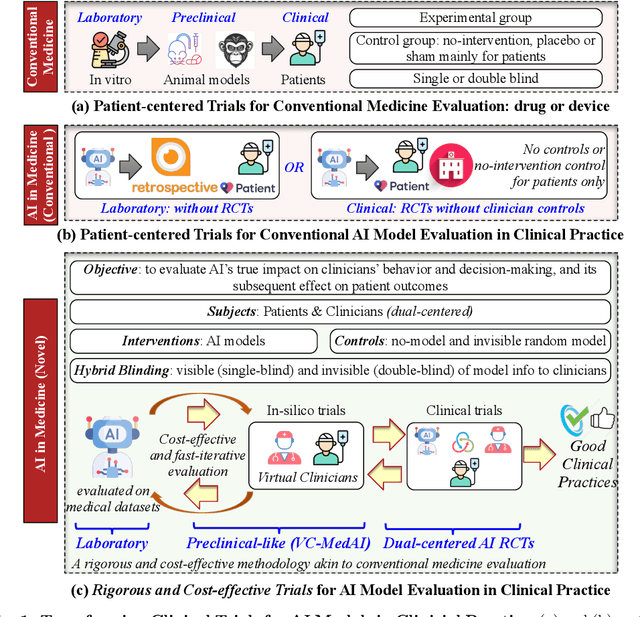
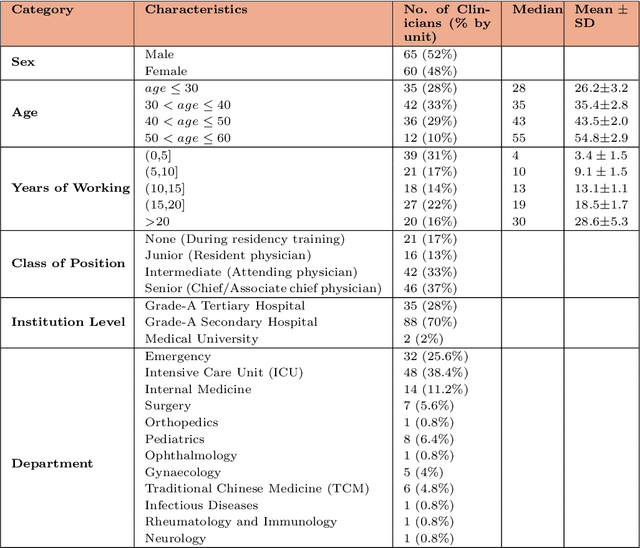
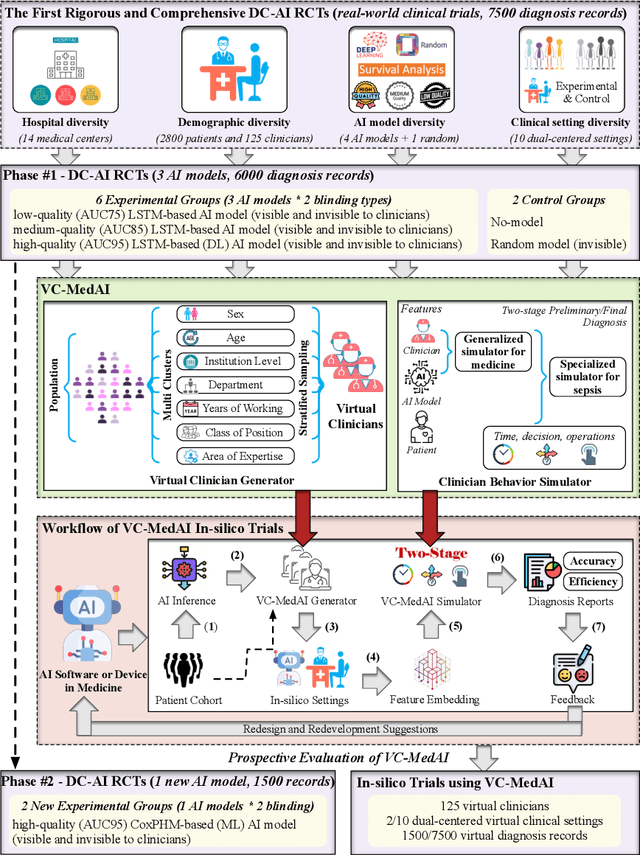
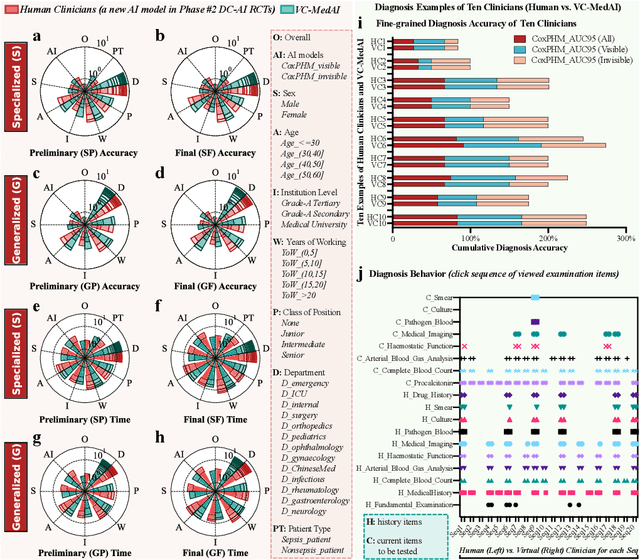
Abstract:A profound gap persists between artificial intelligence (AI) and clinical practice in medicine, primarily due to the lack of rigorous and cost-effective evaluation methodologies. State-of-the-art and state-of-the-practice AI model evaluations are limited to laboratory studies on medical datasets or direct clinical trials with no or solely patient-centered controls. Moreover, the crucial role of clinicians in collaborating with AI, pivotal for determining its impact on clinical practice, is often overlooked. For the first time, we emphasize the critical necessity for rigorous and cost-effective evaluation methodologies for AI models in clinical practice, featuring patient/clinician-centered (dual-centered) AI randomized controlled trials (DC-AI RCTs) and virtual clinician-based in-silico trials (VC-MedAI) as an effective proxy for DC-AI RCTs. Leveraging 7500 diagnosis records from two-phase inaugural DC-AI RCTs across 14 medical centers with 125 clinicians, our results demonstrate the necessity of DC-AI RCTs and the effectiveness of VC-MedAI. Notably, VC-MedAI performs comparably to human clinicians, replicating insights and conclusions from prospective DC-AI RCTs. We envision DC-AI RCTs and VC-MedAI as pivotal advancements, presenting innovative and transformative evaluation methodologies for AI models in clinical practice, offering a preclinical-like setting mirroring conventional medicine, and reshaping development paradigms in a cost-effective and fast-iterative manner. Chinese Clinical Trial Registration: ChiCTR2400086816.
AdaPI: Facilitating DNN Model Adaptivity for Efficient Private Inference in Edge Computing
Jul 08, 2024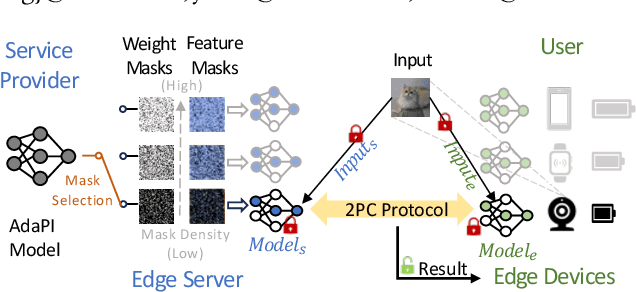

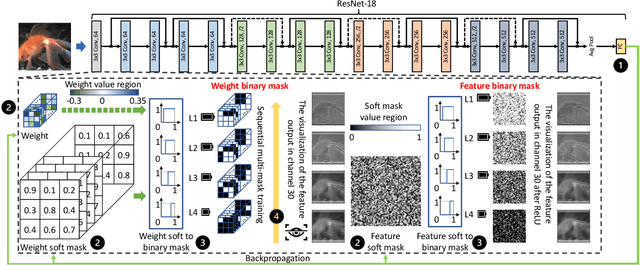

Abstract:Private inference (PI) has emerged as a promising solution to execute computations on encrypted data, safeguarding user privacy and model parameters in edge computing. However, existing PI methods are predominantly developed considering constant resource constraints, overlooking the varied and dynamic resource constraints in diverse edge devices, like energy budgets. Consequently, model providers have to design specialized models for different devices, where all of them have to be stored on the edge server, resulting in inefficient deployment. To fill this gap, this work presents AdaPI, a novel approach that achieves adaptive PI by allowing a model to perform well across edge devices with diverse energy budgets. AdaPI employs a PI-aware training strategy that optimizes the model weights alongside weight-level and feature-level soft masks. These soft masks are subsequently transformed into multiple binary masks to enable adjustments in communication and computation workloads. Through sequentially training the model with increasingly dense binary masks, AdaPI attains optimal accuracy for each energy budget, which outperforms the state-of-the-art PI methods by 7.3\% in terms of test accuracy on CIFAR-100. The code of AdaPI can be accessed via https://github.com/jiahuiiiiii/AdaPI.
APEER: Automatic Prompt Engineering Enhances Large Language Model Reranking
Jun 20, 2024Abstract:Large Language Models (LLMs) have significantly enhanced Information Retrieval (IR) across various modules, such as reranking. Despite impressive performance, current zero-shot relevance ranking with LLMs heavily relies on human prompt engineering. Existing automatic prompt engineering algorithms primarily focus on language modeling and classification tasks, leaving the domain of IR, particularly reranking, underexplored. Directly applying current prompt engineering algorithms to relevance ranking is challenging due to the integration of query and long passage pairs in the input, where the ranking complexity surpasses classification tasks. To reduce human effort and unlock the potential of prompt optimization in reranking, we introduce a novel automatic prompt engineering algorithm named APEER. APEER iteratively generates refined prompts through feedback and preference optimization. Extensive experiments with four LLMs and ten datasets demonstrate the substantial performance improvement of APEER over existing state-of-the-art (SoTA) manual prompts. Furthermore, we find that the prompts generated by APEER exhibit better transferability across diverse tasks and LLMs. Code is available at https://github.com/jincan333/APEER.
Key Information Retrieval to Classify the Unstructured Data Content of Preferential Trade Agreements
Jan 23, 2024Abstract:With the rapid proliferation of textual data, predicting long texts has emerged as a significant challenge in the domain of natural language processing. Traditional text prediction methods encounter substantial difficulties when grappling with long texts, primarily due to the presence of redundant and irrelevant information, which impedes the model's capacity to capture pivotal insights from the text. To address this issue, we introduce a novel approach to long-text classification and prediction. Initially, we employ embedding techniques to condense the long texts, aiming to diminish the redundancy therein. Subsequently,the Bidirectional Encoder Representations from Transformers (BERT) embedding method is utilized for text classification training. Experimental outcomes indicate that our method realizes considerable performance enhancements in classifying long texts of Preferential Trade Agreements. Furthermore, the condensation of text through embedding methods not only augments prediction accuracy but also substantially reduces computational complexity. Overall, this paper presents a strategy for long-text prediction, offering a valuable reference for researchers and engineers in the natural language processing sphere.
MaxK-GNN: Towards Theoretical Speed Limits for Accelerating Graph Neural Networks Training
Dec 18, 2023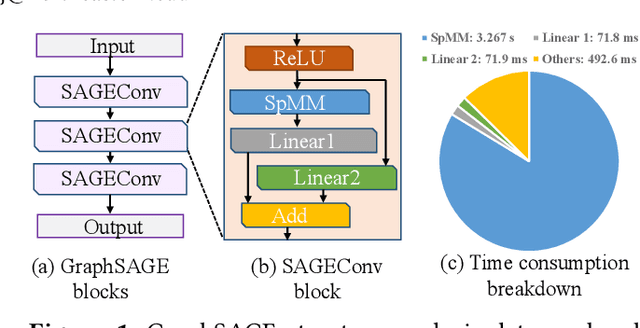

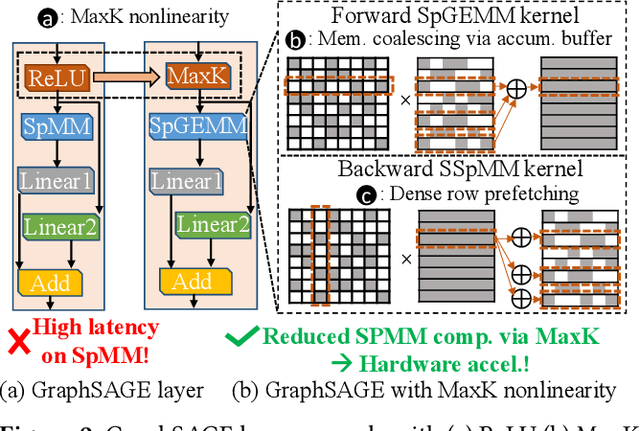
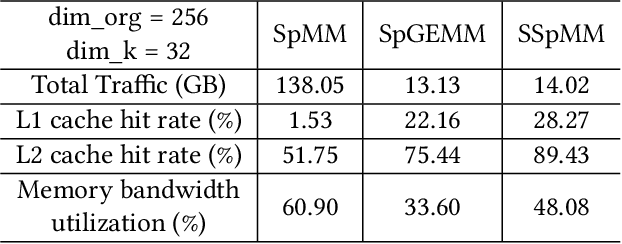
Abstract:In the acceleration of deep neural network training, the GPU has become the mainstream platform. GPUs face substantial challenges on GNNs, such as workload imbalance and memory access irregularities, leading to underutilized hardware. Existing solutions such as PyG, DGL with cuSPARSE, and GNNAdvisor frameworks partially address these challenges but memory traffic is still significant. We argue that drastic performance improvements can only be achieved by the vertical optimization of algorithm and system innovations, rather than treating the speedup optimization as an "after-thought" (i.e., (i) given a GNN algorithm, designing an accelerator, or (ii) given hardware, mainly optimizing the GNN algorithm). In this paper, we present MaxK-GNN, an advanced high-performance GPU training system integrating algorithm and system innovation. (i) We introduce the MaxK nonlinearity and provide a theoretical analysis of MaxK nonlinearity as a universal approximator, and present the Compressed Balanced Sparse Row (CBSR) format, designed to store the data and index of the feature matrix after nonlinearity; (ii) We design a coalescing enhanced forward computation with row-wise product-based SpGEMM Kernel using CBSR for input feature matrix fetching and strategic placement of a sparse output accumulation buffer in shared memory; (iii) We develop an optimized backward computation with outer product-based and SSpMM Kernel. We conduct extensive evaluations of MaxK-GNN and report the end-to-end system run-time. Experiments show that MaxK-GNN system could approach the theoretical speedup limit according to Amdahl's law. We achieve comparable accuracy to SOTA GNNs, but at a significantly increased speed: 3.22/4.24 times speedup (vs. theoretical limits, 5.52/7.27 times) on Reddit compared to DGL and GNNAdvisor implementations.
Advanced Language Model-Driven Verilog Development: Enhancing Power, Performance, and Area Optimization in Code Synthesis
Dec 02, 2023Abstract:The increasing use of Advanced Language Models (ALMs) in diverse sectors, particularly due to their impressive capability to generate top-tier content following linguistic instructions, forms the core of this investigation. This study probes into ALMs' deployment in electronic hardware design, with a specific emphasis on the synthesis and enhancement of Verilog programming. We introduce an innovative framework, crafted to assess and amplify ALMs' productivity in this niche. The methodology commences with the initial crafting of Verilog programming via ALMs, succeeded by a distinct dual-stage refinement protocol. The premier stage prioritizes augmenting the code's operational and linguistic precision, while the latter stage is dedicated to aligning the code with Power-Performance-Area (PPA) benchmarks, a pivotal component in proficient hardware design. This bifurcated strategy, merging error remediation with PPA enhancement, has yielded substantial upgrades in the caliber of ALM-created Verilog programming. Our framework achieves an 81.37% rate in linguistic accuracy and 62.0% in operational efficacy in programming synthesis, surpassing current leading-edge techniques, such as 73% in linguistic accuracy and 46% in operational efficacy. These findings illuminate ALMs' aptitude in tackling complex technical domains and signal a positive shift in the mechanization of hardware design operations.
LinGCN: Structural Linearized Graph Convolutional Network for Homomorphically Encrypted Inference
Sep 30, 2023Abstract:The growth of Graph Convolution Network (GCN) model sizes has revolutionized numerous applications, surpassing human performance in areas such as personal healthcare and financial systems. The deployment of GCNs in the cloud raises privacy concerns due to potential adversarial attacks on client data. To address security concerns, Privacy-Preserving Machine Learning (PPML) using Homomorphic Encryption (HE) secures sensitive client data. However, it introduces substantial computational overhead in practical applications. To tackle those challenges, we present LinGCN, a framework designed to reduce multiplication depth and optimize the performance of HE based GCN inference. LinGCN is structured around three key elements: (1) A differentiable structural linearization algorithm, complemented by a parameterized discrete indicator function, co-trained with model weights to meet the optimization goal. This strategy promotes fine-grained node-level non-linear location selection, resulting in a model with minimized multiplication depth. (2) A compact node-wise polynomial replacement policy with a second-order trainable activation function, steered towards superior convergence by a two-level distillation approach from an all-ReLU based teacher model. (3) an enhanced HE solution that enables finer-grained operator fusion for node-wise activation functions, further reducing multiplication level consumption in HE-based inference. Our experiments on the NTU-XVIEW skeleton joint dataset reveal that LinGCN excels in latency, accuracy, and scalability for homomorphically encrypted inference, outperforming solutions such as CryptoGCN. Remarkably, LinGCN achieves a 14.2x latency speedup relative to CryptoGCN, while preserving an inference accuracy of 75% and notably reducing multiplication depth.
 Add to Chrome
Add to Chrome Add to Firefox
Add to Firefox Add to Edge
Add to Edge